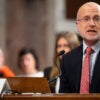Editor’s note: This is a lightly edited transcript of the accompanying video from professor Peter St. Onge.
Regime journalists across America wet themselves last week as year-on-year ticked below 3% for the first time since 2021. As The New York Times put it, “Easing inflation has Democrats tasting victory.”
That’s quite a lot to taste for a 0.1% annual move in inflation—assuming you believe the numbers—especially considering inflation actually went up on the month.
In fact, a more sober reading is that inflation’s been stuck way above the Federal Reserve’s target as that famous transitory inflation logs its 40th month with no end in sight.
More important, falling inflation in a weakening economy is not what the party the communists—er, the journalists—think it is.
Why? Because inflation always falls in recessions. In fact, recessionary deflation is the very excuse Wall Street oligarchs used to install the Fed in the first place: By conflating recession and deflation they gaslit the public into a perpetual inflation machine.
The reason is because a recession means there’s leftover stuff nobody’s buying, so they have to cut the price to move it. Combine that with debt defaults—which effectively unprint dollars—and presto, prices go down.
Not because the Fed or Treasury Secretary Janet Yellen fancy footworked, but because they screwed it up so bad the registers aren’t ringing, and the debtors aren’t paying.
Going to the ticker, in the last four recessions since 1990, inflation has fallen hard every single time.
In 1990 it went from 6.4% to 2.8%—a 3.5-point drop.
In 2001 it dropped 2.5 points—3.7% to 1.2%.
In 2008 it was a 6.5-point drop—from 4.4% inflation to 2% deflation. That was a big one because of debt defaults during the 2008 financial crisis.
Even in the 2020 recession it dropped almost 2.5 points—2.5% to 0.2%.
Tally it up and in the last 35 years and recessions themselves dropped inflation by 3.7% on average.
In other words, that media darling 0.1-point drop could be a downpayment on a lot of pain to come.
Media will keep trying to spin molehills into mountains in hopes they can carry cackles over the finish line come November.
But we know from rising federal spending that inflation isn’t going anywhere. Meaning any improvement is likely coming from the slowing economy itself—unsold goods, unemployed workers, and lower energy prices as people cut back on driving—which surveys say they already are.
So, what’s next? In theory the Fed’s supposed to delicately balance inflation and unemployment. In fact, today the Fed is painting itself into a tighter and tighter corner, trapped between spending-driven inflation and inflation-driven job losses.
The one solution—cutting federal spending—is the one solution they will never do. Because federal spending is the whole point of having a central bank. It’s the government’s payback for handing Wall Street a license to print money.
I mentioned last week how easy it is to get out of this, to back the dollar with hard money so they can’t inflate.
Instead, as always, the Fed will pretend everything is fine—and the media will dutifully play along—right up until the day they all sing as one how nobody could have seen it coming.
We publish a variety of perspectives. Nothing written here is to be construed as representing the views of The Daily Signal.































